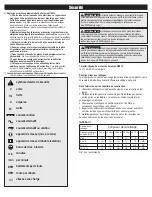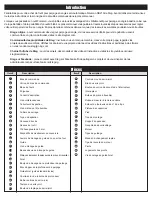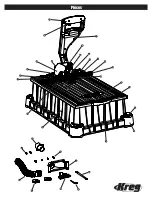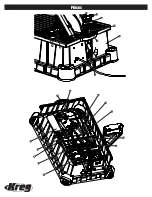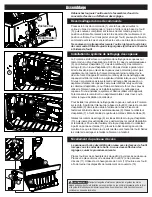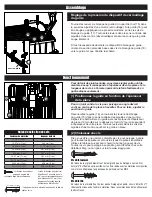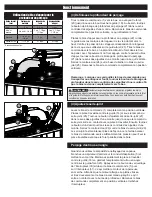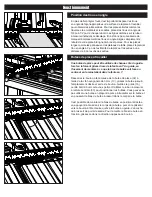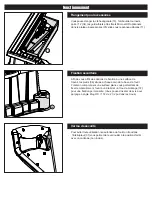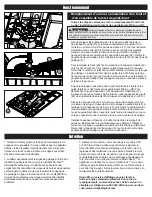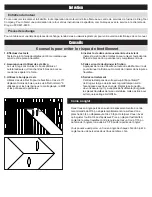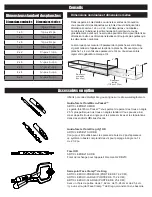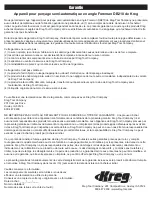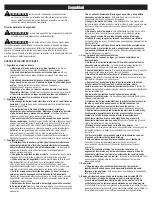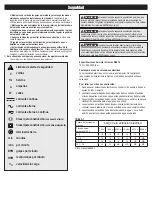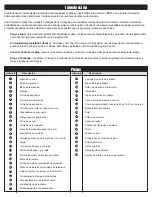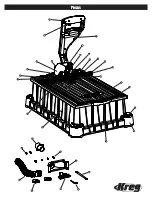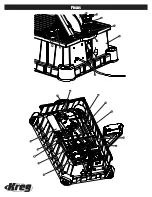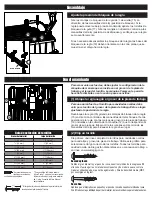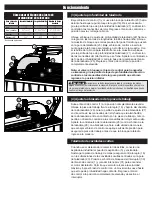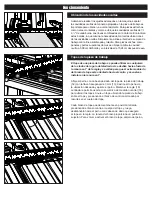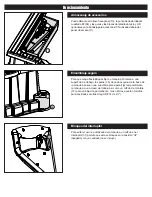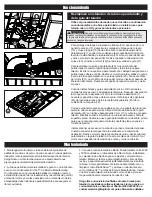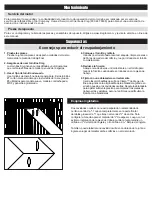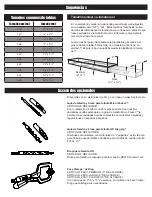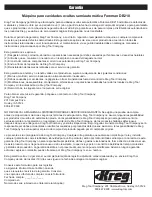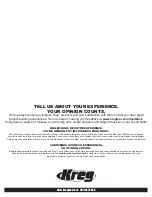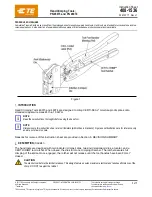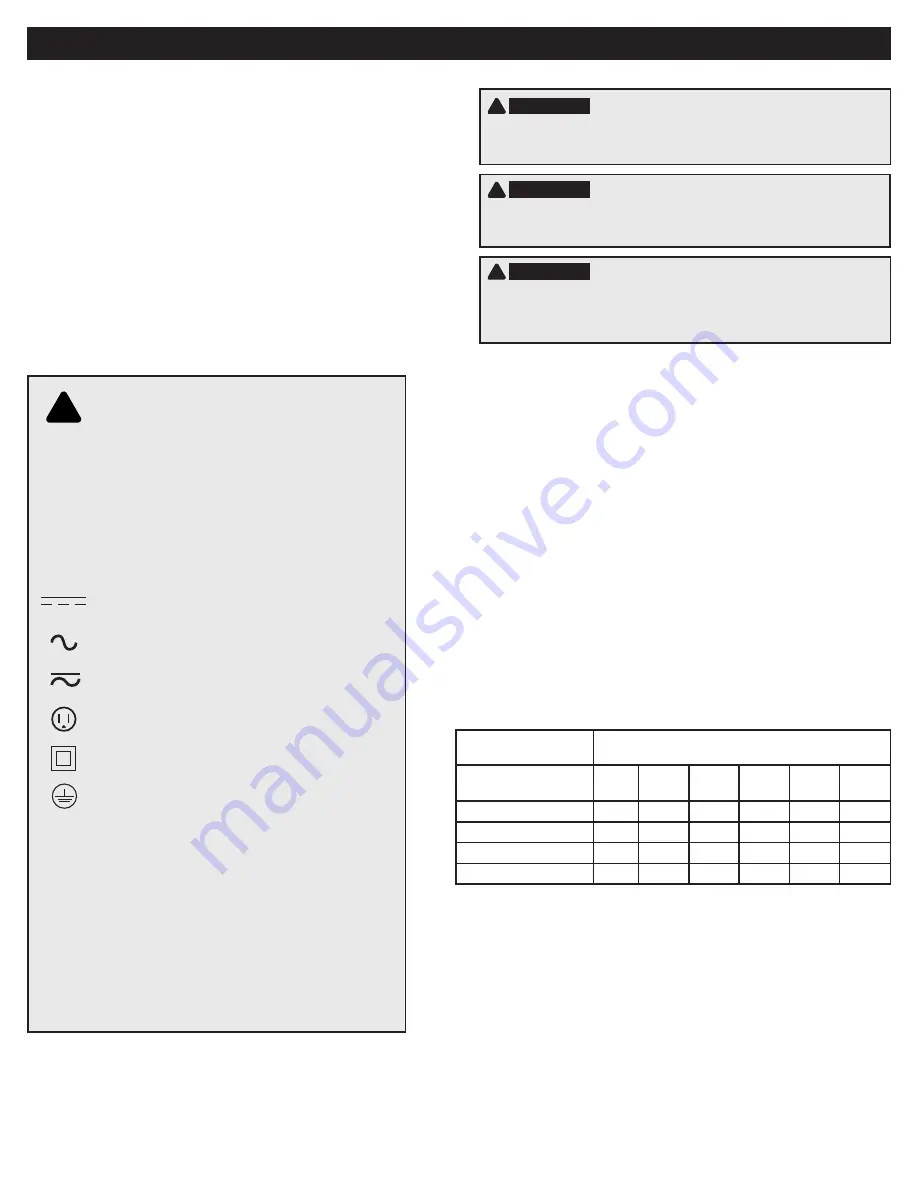
Seguridad
b)
Manipule con cuidado las guías para taladro y mantenga las manos
alejadas cuando estén instaladas en la máquina.
El espacio mínimo
requerido entre la broca y la guía para taladro para mejorar la calidad del
orificio produce un borde afilado que puede suponer un riesgo de laceración.
c)
Mantenga las manos alejadas de la broca giratoria y de la abrazadera
de la pieza de trabajo mientras opere la máquina.
d)
Asegúrese de que la broca esté completamente separada de la pieza
de trabajo y que se detenga completamente antes de regular la posición
de la pieza de trabajo.
e)
Asegure la máquina para evitar inclinaciones o deslices.
No se pare
sobre la máquina.
f)
Siga todas las prácticas de lubricación y mantenimiento que se
detallan en el manual de instrucciones.
g)
Esta máquina está diseñada para una aplicación específica. No la
modifique ni la use para otra aplicación.
Si tiene preguntas relacionadas con
la aplicación de la máquina, NO la use hasta ponerse en contacto con Kreg Tool
Company y recibir la orientación correspondiente.
7)
En la etiqueta de su máquina pueden aparecer los siguientes símbolos.
TLos símbolos y sus definiciones son los siguientes:
Propuesta 65 de California
Especificaciones del motor Foreman DB210
120 V~5.0A 2800 rpm
Pautas para el uso de extensiones eléctricas
Las extensiones eléctricas son solo para uso temporal. No reemplazan
la necesidad de instalar tomacorrientes y cableado adecuado donde sea
necesario.
En el taller y en sitios de construcción:
1. Se deben usar extensiones eléctricas con conductor de puesta a tierra del
equipo en todo momento.
2. Las extensiones eléctricas deben protegerse de daños y no deben tenderse
a través de puertas o ventanas, ya que estas puedan cerrarse y dañar el cable.
3. Las extensiones eléctricas deben ser de 16 AWG como mínimo y tener una
clasificación adecuada para el equipo que se utiliza.
4. Las extensiones eléctricas deben inspeccionarse periódicamente para
controlar que el aislamiento y la conductividad no se vean comprometidos.
5. Las extensiones eléctricas no deben tenderse sobre agua, y no se debe
permitir que las conexiones estén expuestas a agua acumulada.
Calibre de la extensión
eléctrica
Largo de la extensión eléctrica
Placa de datos:
amperios a120 V
7,62 m 15,24 m 22,86 m 30,48 m 45,72 m 60,96 m
0 - 5
16
16
16
14
12
12
5.1 - 8
16
16
14
12
10
NR
8.1 -12
14
14
12
10
NR
NR
12.1 - 16
12
12
NR
NR
NR
NR
NR: no recomendado
TABLA 1
símbolo de alerta de seguridad
voltios
hercios
amperios
vatios
corriente continua
corriente alterna
corriente alterna o continua
Clase I para construcción
(con puesta a tierra)
Clase II para construcción
(con doble aislamiento)
terminal de tierra
minutos
por minuto
golpes por minuto
revoluciones por minuto
velocidad sin carga
V
Hz
A
W
min
/min
BPM
RPM
!
English
3
• Be sure that the cutter knives are mounted as described in the
instruction manual and check that all bolts are firmly tightened
before connecting unit to power source.
• To avoid injury, never rotate the cutter block directly with your
hands.
• Keep guards in place and in good working order.
• Stay alert – never operate the unit when tired or under the
influence of drugs, alcohol, or medication.
• Do not use in dangerous environments. Do not use near
flammable substances, in damp or wet locations, or expose to
rain.
• Never plane material which is shorter than 12 inches.
• Exhaust chute: remove shavings with brush or vacuum after
power has been shut off and cutter head has stopped rotating.
• ALWAYS LOCATE PLANER WITH PROPER CLEARANCE ON
THE OUTFEED SIDE of the unit to prevent pinching or binding of
the workpiece against any obstacle.
•
Clean out your tool often, especially after heavy use.
Dust
and grit containing metal particles often accumulate on interior
surfaces and could create a risk of serious injury, electric shock or
electrocution. ALWAYS WEAR SAFETY GLASSES.
WARNING:
For your own safety, it is recommended that two
people carry this machine or serious injury could result.
WARNING: Always wear proper personal hearing protection
that conforms to ANSI S12.6 (S3.19) during use.
Under some
conditions and duration of use, noise from this product may
contribute to hearing loss.
WARNING:
Some dust created by power sanding, sawing,
grinding, drilling, and other construction activities contains chemicals
known to the State of California to cause cancer, birth defects or
other reproductive harm. Some examples of these chemicals are:
• lead from lead-based paints,
•
crystalline silica from bricks and cement and other masonry
products, and
• arsenic and chromium from chemically-treated lumber.
Your risk from these exposures varies, depending on how often you
do this type of work. To reduce your exposure to these chemicals:
work in a well ventilated area, and work with approved safety
equipment, such as those dust masks that are specially designed to
filter out microscopic particles.
•
Avoid prolonged contact with dust from power sanding,
sawing, grinding, drilling, and other construction activities.
Wear protective clothing and wash exposed areas with
soap and water.
Allowing dust to get into your mouth, eyes, or
lay on the skin may promote absorption of harmful chemicals.
WARNING:
A dust mask or respirator should be worn by all
persons entering the work area. The filter should be replaced daily or
whenever the wearer has difficulty breathing. See your local hardware
store for the proper NIOSH/OSHA approved dust mask.
• The label on your tool may include the following symbols. The
symbols and their definitions are as follows:
V ......... volts
A .......amperes
Hz ....... hertz
W ......watts
min ..... minutes
.....alternating current
... direct current
.....alternating or direct current
....... Class I Construction
no ......no load speed
...........
(grounded)
......earthing terminal
....... Class II Construction
.....safety alert symbol
...........
(double insulated)
BPM ..beats per minute
…/min per minute
RPM ..revolutions per minute
English
3
• Be sure that the cutter knives are mounted as described in the
instruction manual and check that all bolts are firmly tightened
before connecting unit to power source.
• To avoid injury, never rotate the cutter block directly with your
hands.
• Keep guards in place and in good working order.
• Stay alert – never operate the unit when tired or under the
influence of drugs, alcohol, or medication.
• Do not use in dangerous environments. Do not use near
flammable substances, in damp or wet locations, or expose to
rain.
• Never plane material which is shorter than 12 inches.
• Exhaust chute: remove shavings with brush or vacuum after
power has been shut off and cutter head has stopped rotating.
• ALWAYS LOCATE PLANER WITH PROPER CLEARANCE ON
THE OUTFEED SIDE of the unit to prevent pinching or binding of
the workpiece against any obstacle.
•
Clean out your tool often, especially after heavy use.
Dust
and grit containing metal particles often accumulate on interior
surfaces and could create a risk of serious injury, electric shock or
electrocution. ALWAYS WEAR SAFETY GLASSES.
WARNING:
For your own safety, it is recommended that two
people carry this machine or serious injury could result.
WARNING: Always wear proper personal hearing protection
that conforms to ANSI S12.6 (S3.19) during use.
Under some
conditions and duration of use, noise from this product may
contribute to hearing loss.
WARNING:
Some dust created by power sanding, sawing,
grinding, drilling, and other construction activities contains chemicals
known to the State of California to cause cancer, birth defects or
other reproductive harm. Some examples of these chemicals are:
• lead from lead-based paints,
•
crystalline silica from bricks and cement and other masonry
products, and
• arsenic and chromium from chemically-treated lumber.
Your risk from these exposures varies, depending on how often you
do this type of work. To reduce your exposure to these chemicals:
work in a well ventilated area, and work with approved safety
equipment, such as those dust masks that are specially designed to
filter out microscopic particles.
•
Avoid prolonged contact with dust from power sanding,
sawing, grinding, drilling, and other construction activities.
Wear protective clothing and wash exposed areas with
soap and water.
Allowing dust to get into your mouth, eyes, or
lay on the skin may promote absorption of harmful chemicals.
WARNING:
A dust mask or respirator should be worn by all
persons entering the work area. The filter should be replaced daily or
whenever the wearer has difficulty breathing. See your local hardware
store for the proper NIOSH/OSHA approved dust mask.
• The label on your tool may include the following symbols. The
symbols and their definitions are as follows:
V ......... volts
A .......amperes
Hz ....... hertz
W ......watts
min ..... minutes
.....alternating current
... direct current
.....alternating or direct current
....... Class I Construction
no ......no load speed
...........
(grounded)
......earthing terminal
....... Class II Construction
.....safety alert symbol
...........
(double insulated)
BPM ..beats per minute
…/min per minute
RPM ..revolutions per minute
English
3
• Be sure that the cutter knives are mounted as described in the
instruction manual and check that all bolts are firmly tightened
before connecting unit to power source.
• To avoid injury, never rotate the cutter block directly with your
hands.
• Keep guards in place and in good working order.
• Stay alert – never operate the unit when tired or under the
influence of drugs, alcohol, or medication.
• Do not use in dangerous environments. Do not use near
flammable substances, in damp or wet locations, or expose to
rain.
• Never plane material which is shorter than 12 inches.
• Exhaust chute: remove shavings with brush or vacuum after
power has been shut off and cutter head has stopped rotating.
• ALWAYS LOCATE PLANER WITH PROPER CLEARANCE ON
THE OUTFEED SIDE of the unit to prevent pinching or binding of
the workpiece against any obstacle.
•
Clean out your tool often, especially after heavy use.
Dust
and grit containing metal particles often accumulate on interior
surfaces and could create a risk of serious injury, electric shock or
electrocution. ALWAYS WEAR SAFETY GLASSES.
WARNING:
For your own safety, it is recommended that two
people carry this machine or serious injury could result.
WARNING: Always wear proper personal hearing protection
that conforms to ANSI S12.6 (S3.19) during use.
Under some
conditions and duration of use, noise from this product may
contribute to hearing loss.
WARNING:
Some dust created by power sanding, sawing,
grinding, drilling, and other construction activities contains chemicals
known to the State of California to cause cancer, birth defects or
other reproductive harm. Some examples of these chemicals are:
• lead from lead-based paints,
•
crystalline silica from bricks and cement and other masonry
products, and
• arsenic and chromium from chemically-treated lumber.
Your risk from these exposures varies, depending on how often you
do this type of work. To reduce your exposure to these chemicals:
work in a well ventilated area, and work with approved safety
equipment, such as those dust masks that are specially designed to
filter out microscopic particles.
•
Avoid prolonged contact with dust from power sanding,
sawing, grinding, drilling, and other construction activities.
Wear protective clothing and wash exposed areas with
soap and water.
Allowing dust to get into your mouth, eyes, or
lay on the skin may promote absorption of harmful chemicals.
WARNING:
A dust mask or respirator should be worn by all
persons entering the work area. The filter should be replaced daily or
whenever the wearer has difficulty breathing. See your local hardware
store for the proper NIOSH/OSHA approved dust mask.
• The label on your tool may include the following symbols. The
symbols and their definitions are as follows:
V ......... volts
A .......amperes
Hz ....... hertz
W ......watts
min ..... minutes
.....alternating current
... direct current
.....alternating or direct current
....... Class I Construction
no ......no load speed
...........
(grounded)
......earthing terminal
....... Class II Construction
.....safety alert symbol
...........
(double insulated)
BPM ..beats per minute
…/min per minute
RPM ..revolutions per minute
English
3
• Be sure that the cutter knives are mounted as described in the
instruction manual and check that all bolts are firmly tightened
before connecting unit to power source.
• To avoid injury, never rotate the cutter block directly with your
hands.
• Keep guards in place and in good working order.
• Stay alert – never operate the unit when tired or under the
influence of drugs, alcohol, or medication.
• Do not use in dangerous environments. Do not use near
flammable substances, in damp or wet locations, or expose to
rain.
• Never plane material which is shorter than 12 inches.
• Exhaust chute: remove shavings with brush or vacuum after
power has been shut off and cutter head has stopped rotating.
• ALWAYS LOCATE PLANER WITH PROPER CLEARANCE ON
THE OUTFEED SIDE of the unit to prevent pinching or binding of
the workpiece against any obstacle.
•
Clean out your tool often, especially after heavy use.
Dust
and grit containing metal particles often accumulate on interior
surfaces and could create a risk of serious injury, electric shock or
electrocution. ALWAYS WEAR SAFETY GLASSES.
WARNING:
For your own safety, it is recommended that two
people carry this machine or serious injury could result.
WARNING: Always wear proper personal hearing protection
that conforms to ANSI S12.6 (S3.19) during use.
Under some
conditions and duration of use, noise from this product may
contribute to hearing loss.
WARNING:
Some dust created by power sanding, sawing,
grinding, drilling, and other construction activities contains chemicals
known to the State of California to cause cancer, birth defects or
other reproductive harm. Some examples of these chemicals are:
• lead from lead-based paints,
•
crystalline silica from bricks and cement and other masonry
products, and
• arsenic and chromium from chemically-treated lumber.
Your risk from these exposures varies, depending on how often you
do this type of work. To reduce your exposure to these chemicals:
work in a well ventilated area, and work with approved safety
equipment, such as those dust masks that are specially designed to
filter out microscopic particles.
•
Avoid prolonged contact with dust from power sanding,
sawing, grinding, drilling, and other construction activities.
Wear protective clothing and wash exposed areas with
soap and water.
Allowing dust to get into your mouth, eyes, or
lay on the skin may promote absorption of harmful chemicals.
WARNING:
A dust mask or respirator should be worn by all
persons entering the work area. The filter should be replaced daily or
whenever the wearer has difficulty breathing. See your local hardware
store for the proper NIOSH/OSHA approved dust mask.
• The label on your tool may include the following symbols. The
symbols and their definitions are as follows:
V ......... volts
A .......amperes
Hz ....... hertz
W ......watts
min ..... minutes
.....alternating current
... direct current
.....alternating or direct current
....... Class I Construction
no ......no load speed
...........
(grounded)
......earthing terminal
....... Class II Construction
.....safety alert symbol
...........
(double insulated)
BPM ..beats per minute
…/min per minute
RPM ..revolutions per minute
English
3
• Be sure that the cutter knives are mounted as described in the
instruction manual and check that all bolts are firmly tightened
before connecting unit to power source.
• To avoid injury, never rotate the cutter block directly with your
hands.
• Keep guards in place and in good working order.
• Stay alert – never operate the unit when tired or under the
influence of drugs, alcohol, or medication.
• Do not use in dangerous environments. Do not use near
flammable substances, in damp or wet locations, or expose to
rain.
• Never plane material which is shorter than 12 inches.
• Exhaust chute: remove shavings with brush or vacuum after
power has been shut off and cutter head has stopped rotating.
• ALWAYS LOCATE PLANER WITH PROPER CLEARANCE ON
THE OUTFEED SIDE of the unit to prevent pinching or binding of
the workpiece against any obstacle.
•
Clean out your tool often, especially after heavy use.
Dust
and grit containing metal particles often accumulate on interior
surfaces and could create a risk of serious injury, electric shock or
electrocution. ALWAYS WEAR SAFETY GLASSES.
WARNING:
For your own safety, it is recommended that two
people carry this machine or serious injury could result.
WARNING: Always wear proper personal hearing protection
that conforms to ANSI S12.6 (S3.19) during use.
Under some
conditions and duration of use, noise from this product may
contribute to hearing loss.
WARNING:
Some dust created by power sanding, sawing,
grinding, drilling, and other construction activities contains chemicals
known to the State of California to cause cancer, birth defects or
other reproductive harm. Some examples of these chemicals are:
• lead from lead-based paints,
•
crystalline silica from bricks and cement and other masonry
products, and
• arsenic and chromium from chemically-treated lumber.
Your risk from these exposures varies, depending on how often you
do this type of work. To reduce your exposure to these chemicals:
work in a well ventilated area, and work with approved safety
equipment, such as those dust masks that are specially designed to
filter out microscopic particles.
•
Avoid prolonged contact with dust from power sanding,
sawing, grinding, drilling, and other construction activities.
Wear protective clothing and wash exposed areas with
soap and water.
Allowing dust to get into your mouth, eyes, or
lay on the skin may promote absorption of harmful chemicals.
WARNING:
A dust mask or respirator should be worn by all
persons entering the work area. The filter should be replaced daily or
whenever the wearer has difficulty breathing. See your local hardware
store for the proper NIOSH/OSHA approved dust mask.
• The label on your tool may include the following symbols. The
symbols and their definitions are as follows:
V ......... volts
A .......amperes
Hz ....... hertz
W ......watts
min ..... minutes
.....alternating current
... direct current
.....alternating or direct current
....... Class I Construction
no ......no load speed
...........
(grounded)
......earthing terminal
....... Class II Construction
.....safety alert symbol
...........
(double insulated)
BPM ..beats per minute
…/min per minute
RPM ..revolutions per minute
English
3
• Be sure that the cutter knives are mounted as described in the
instruction manual and check that all bolts are firmly tightened
before connecting unit to power source.
• To avoid injury, never rotate the cutter block directly with your
hands.
• Keep guards in place and in good working order.
• Stay alert – never operate the unit when tired or under the
influence of drugs, alcohol, or medication.
• Do not use in dangerous environments. Do not use near
flammable substances, in damp or wet locations, or expose to
rain.
• Never plane material which is shorter than 12 inches.
• Exhaust chute: remove shavings with brush or vacuum after
power has been shut off and cutter head has stopped rotating.
• ALWAYS LOCATE PLANER WITH PROPER CLEARANCE ON
THE OUTFEED SIDE of the unit to prevent pinching or binding of
the workpiece against any obstacle.
•
Clean out your tool often, especially after heavy use.
Dust
and grit containing metal particles often accumulate on interior
surfaces and could create a risk of serious injury, electric shock or
electrocution. ALWAYS WEAR SAFETY GLASSES.
WARNING:
For your own safety, it is recommended that two
people carry this machine or serious injury could result.
WARNING: Always wear proper personal hearing protection
that conforms to ANSI S12.6 (S3.19) during use.
Under some
conditions and duration of use, noise from this product may
contribute to hearing loss.
WARNING:
Some dust created by power sanding, sawing,
grinding, drilling, and other construction activities contains chemicals
known to the State of California to cause cancer, birth defects or
other reproductive harm. Some examples of these chemicals are:
• lead from lead-based paints,
•
crystalline silica from bricks and cement and other masonry
products, and
• arsenic and chromium from chemically-treated lumber.
Your risk from these exposures varies, depending on how often you
do this type of work. To reduce your exposure to these chemicals:
work in a well ventilated area, and work with approved safety
equipment, such as those dust masks that are specially designed to
filter out microscopic particles.
•
Avoid prolonged contact with dust from power sanding,
sawing, grinding, drilling, and other construction activities.
Wear protective clothing and wash exposed areas with
soap and water.
Allowing dust to get into your mouth, eyes, or
lay on the skin may promote absorption of harmful chemicals.
WARNING:
A dust mask or respirator should be worn by all
persons entering the work area. The filter should be replaced daily or
whenever the wearer has difficulty breathing. See your local hardware
store for the proper NIOSH/OSHA approved dust mask.
• The label on your tool may include the following symbols. The
symbols and their definitions are as follows:
V ......... volts
A .......amperes
Hz ....... hertz
W ......watts
min ..... minutes
.....alternating current
... direct current
.....alternating or direct current
....... Class I Construction
no ......no load speed
...........
(grounded)
......earthing terminal
....... Class II Construction
.....safety alert symbol
...........
(double insulated)
BPM ..beats per minute
…/min per minute
RPM ..revolutions per minute
Advertencia:
!
este producto puede exponerlo a sustancias químicas, que
incluyen el plomo, reconocidas por el estado de California como causantes de
cáncer y defectos congénitos u otros daños en el aparato reproductivo. Para obtener
más información, viste www.P65Warnings.ca.gov.
Advertencia:
!
este producto puede exponerlo a sustancias químicas,
que incluyen el plomo, entre otras, reconocidas por el estado de California como
causantes de cáncer y defectos congénitos u otros daños en el aparato reproductivo.
Para obtener más información, viste www.P65Warnings.ca.gov.
Advertencia:
!
los productos para taladrar, aserrar, lijar o cortar madera
pueden exponerlo al polvo de madera, una sustancia reconocida por el estado de
California como causante de cáncer. Evite inhalar el polvo de la madera o utilice
una mascarilla antipolvo u otros artículos de protección personal. Para obtener más
información, viste www.P65Warnings.ca.gov.
Содержание FOREMAN DB210
Страница 5: ...Parts 10 6 5 7 4 32 32 36 37 11 4 15 25 31 30 1 33 16 15 29 28 27 9 22 34 13 8 12 26 23 21 17 17 3 ...
Страница 6: ...Parts 4 2 24 15 21 25 15 19 3 40 4 35 39 38 14 43 46 14 23 41 20 ...
Страница 19: ...Pièces 10 6 5 7 4 32 32 36 37 11 4 15 25 31 30 1 33 16 15 29 28 27 9 22 34 13 8 12 26 23 21 17 17 3 ...
Страница 20: ...Pièces 4 2 24 15 21 25 15 19 3 40 4 35 39 38 14 43 46 14 23 41 20 ...
Страница 33: ...Piezas 10 6 5 7 4 32 32 36 37 11 4 15 25 31 30 1 33 16 15 29 28 27 9 22 34 13 8 12 26 23 21 17 17 3 ...
Страница 34: ...Piezas 4 2 24 15 21 25 15 19 3 40 4 35 39 38 14 43 46 14 23 41 20 ...

